|
EQUINE CLICKER TRAINING..... using precision and positive reinforcement to teach horses and people |


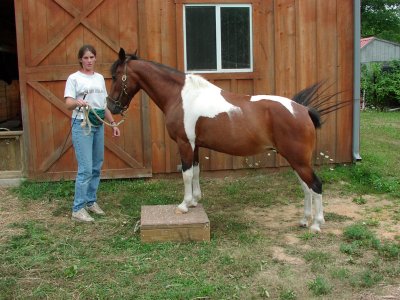
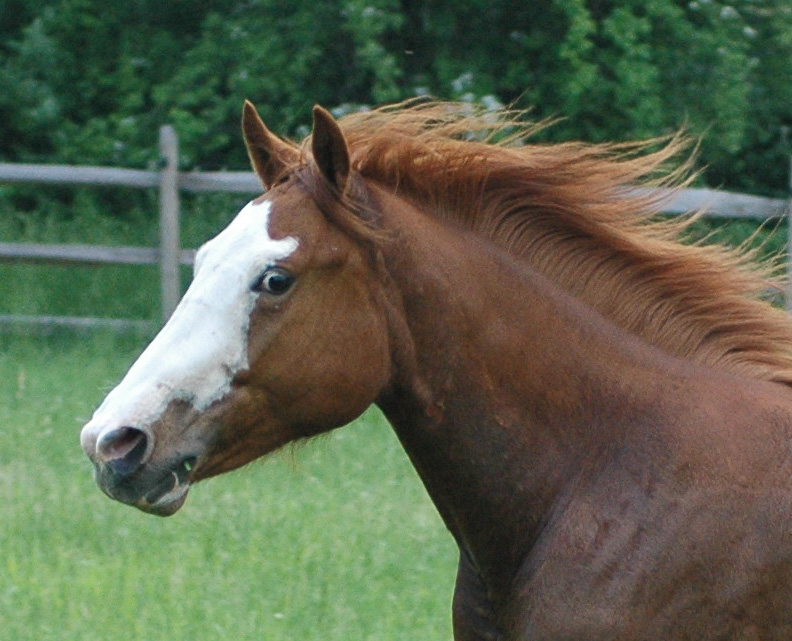
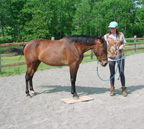

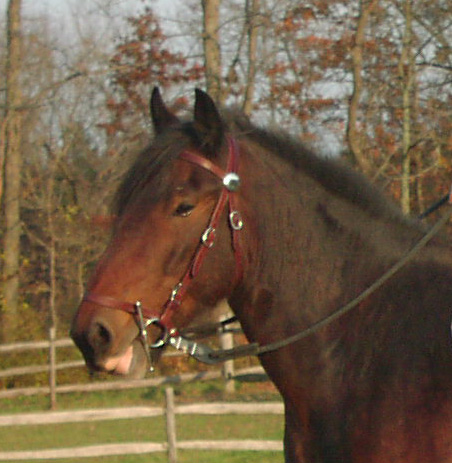
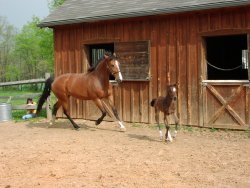 |
|
How to Interpret and Manage Energy, Excitement and Tension
As a child and young adult working with horses, I was certainly aware that there were some horses that were more energetic and high strung than others. And that there were some conditions under which horses tended to get more excited (cold, windy days, going to a new place, etc...). I just assumed that this was part of any horse's personality or temperament and a good horseperson learned how to handle these types of horses and under these conditions. In most cases, I learned to either find a safe outlet for the energy by allowing the horse to burn off some steam by moving, or I learned to allow the horse time to settle down and calm himself. It was not until I started clicker training and working with Alexandra Kurland that I started to realize how much we can affect and control our horse's state of mind by choosing appropriate exercises and teaching the horse that it is ok to be calm, even in a strange place or under conditions that usually generate excitement and/or anxiety.
In horses, their emotional state is very closely tied in to body position and posture. A grazing horse is calm and relaxed with its head down. An excited horse has its head up and is looking around. Often its whole body is tense and it will be ready to run at a moment's notice. A horse that is excited, but in a more positive way (not fear) might arch its neck and dance around. When we work with horses, it can be very helpful to teach a horse to adopt a body position that is tied to the emotion we desire at the time. This is one reason you read about teaching horses head down as a calm down cue. A horse with a low head is going to calm himself, as long as he is choosing to put his head down voluntarily. Horses that are forced to carry their heads low by the use of force or equipment are not going to find the inner calmness that a horse gets when it drops its head voluntarily. With clicker training, we can teach a horse to put his head down voluntarily and use that behavior to help the horse find calm in an unsettling situation.
The opposite is also true. We can teach a horse to carry himself in a way that is associated with excitement and energy, but without the high emotions that are connected with it. Simple examples of this are horses that have been taught to run fast, rear, spin, and buck on cue. If the behavior has been well trained, the horse will be calm between requests. If the horse is still getting emotionally wound up when performing these behaviors, that is a message that more work needs to be done on teaching the horse to perform the desired behavior with energy and then relax. It is normal for horses to get wound up, even when doing well trained behaviors so I am not saying that an increase in general energy and excitement is bad. I am saying that if the horse gets so excited by the high energy behavior that he is then not easily controlled by the handler, then there is more work to be done.
As a dressage rider, I want to teach my horse to perform behaviors that are normally associated with excitement without tapping into the mental or emotional state that usually accompanies them. I want my horse to lift and carry himself in a certain posture and level of self carriage that incorporates correct use of his back, hind end and neck. In the early training, I am going to emphasize having the horse calm and relaxed and soft through his topline. But as the horse develops, I am going to ask for more collection and a higher energy level so that I can eventually do extended gaits, advanced canter work, piaffe and passage. The level of engagement, self carriage and elevation that you see in an advanced dressage horse is not a natural position for a horse to adopt when he is relaxed and calm. In general, the only time I see most horses carrying themselves this way is when they are very excited and/or anxious about something. It could be excitement because the horse has spotted something new or unusual, is interested in another horse, or is just full of energy. At this point, it is important that we not label energy and excitement as either good or bad. We need some energy, sometimes we need a lot of energy, for the horse to do his job well. But we also need to recognize that we don't always want the emotions associated with energy and the behaviors that horses do when they are in that state.
I want to teach my horse to carry himself in one way, but
without the adrenaline rush or excitement that goes with it. I am ok with
some of that energy, but I want to know that I can control it and that the
horse is paying attention to me and not on his own program.
I spent 20+ years in the traditional horse world before I found clicker
I want
to make an "aside" here. This article is an expanded version of a post I sent to
the BBECT list in response to a question by a dog agility trainer who clicker
trains her dogs. She likes her dogs to be excited and anxious to start the
agility course and was looking for the same type of enthusiasm in her horse
before she went in for a jumping round. While I think we all want our
horses to be enthusiastic and happy about their work, horses are different than
dogs and need to be handled as such. There are all kinds of safety
considerations here, but there are also differences in horse and dog behavior
that we have to take into account. As horse owners, we need to learn to
read our horses to know that a horse that is anxious to go and seems
enthusiastic about something might be anxious and upset because it wants to move
or get away from something and can't. I prefer to see a horse that is
clearly alert and interested, but does not have tension in its body. Some
clicker trained horses do get enthusiastic and energetic during their sessions,
but if they are offering trained behaviors in an appropriate manner, I do not
consider this being anxiety.
That doesn't mean my horses don't end up stressed at times during the training, but I do try to avoid it or keep it very minimal. Yes, I do need to keep asking for more from my horse in order to keep the training progressing, but I do this at a level where the horse is still ok. Maybe this is just all a bunch of semantics, but I don't think so. The trainer's intent matters here. If I am trying to teach my horse something new and he gets upset/frustrated/"stressed," I might permit it for a few moments just to see if the horse can work through it or not. But if the horse goes beyond a certain level (depends upon the horse, behavior, situation etc..), then I will change my training plan. I do believe that animals do need to learn to deal with frustration, but I am not going to purposely work on that until I have a lot of basic behavior and training tools that I can use to manage that.
I spent the last two
winters taking Rosie to a neighboring indoor and teaching her that it was a
place where she could be calm and quiet. When I first took her, people
Now I can take her and work quietly
and I know the people there scratch their heads. She doesn't have the
"flash" and "spirit" that she had before. But I know it is
still there. What she has learned is that it is ok to be quiet and calm in a new
place and I have not suppressed her, I have just taught her another behavior to
do when she is upset. The energy and desire to go is still there, she is just
waiting for me to tell her when it is something I want. Recently I
have been experimenting with allowing her to add energy to see if she can
handle it. What I am getting now is a horse that can work quietly when
asked, but is capable of working with greater energy and doesn't let it go
Unlike
some other behaviors where I have a standard progression and it is easy to write
down how to set up a training plan, teaching emotional control and learning to
manage a horse's energy level is not quite so clear. When, I am working a
horse, I use a lot of factors to decide how much energy I want at any given
time and I'm not sure I could describe it here without getting way too
complicated, so I am just going to illustrate it with numbers. I can look at
energy levels is on a scale of 1-10. 1 would be the horse who is very quiet,
happy to stand still and do nothing, but not very alert or watchful either. 10
would be the totally overwhelmed horse that just wants to move, move, move. I
don't actually go out and get on my horse and say "Gee, He is a 7 today," but I
do get on my horse and say "How are you feeling?" So please don't take the
numbering idea as a rigid system or exactly how to do it. It is just an example
of a way to look at it. And the nice thing about numbers is that they are very
impersonal. If I get on my horse and he is a 7, I can say "ok, how do I get him
to 5" instead of saying "oh no, my horse is dancing around all over the place,
what do I do?"
One of the nice things about clicker training and
Alexandra Kurland's work is that she gives you a lot of tools for dropping a
horse's energy level down without having to either tire him out or bore him, or
resort to mechanical devices. A lot of the softening and single rein work
teaches horses to relax, drop their heads and quiet down. Many of her ridden
exercises and patterns become comforting to anxious horses and you can just pick
an exercise and ride it, clicking in appropriate places and the horse will drop
his energy level down. I have found that just the addition of the click
and treat to any patterned exercise increases the horse's level of calmness and
relaxation. For a horse, knowing exactly what you want is very comforting. So
even if you don't think your horse is learning anything new and you don't want
to click for already learned behavior, you can think of it as clicking for a
learned behavior in a new, higher energy situation.
Even if I wanted to say "well, she is
excited and wants to get to work," I still make sure she can do some slow
and quiet work. I could say that it would be more productive to let her move
for a bit, but I am not always going to have that option. I have no indoor
and in the winter we spend quite a bit of time walking. I need her to be
able to come out and walk quietly around the block, with traffic and dogs
and other distractions. So she has to learn that even when she feels like
going, sometimes she can't.
I am going to end this article with some ideas for helping a horse calm down, and some ideas for helping a horse add energy. But I have to add that this list is full of "it depends" because how you use these exercises makes a difference and the same exercise in different situations can have different results. You can get different results depending upon what you click.
Calming Exercises:
Head down
Stand on your mat
Targeting
Backing
Groundwork in patterns (3 flip 3, Hip Shoulder Shoulder, cone work, lots of gentle turns, bending, lateral work)
Single Rein work: use of one rein does not make the horse feel trapped and the softening, bending and lowering of the head that accompanies single rein work is calming.
Movement: for a horse that is too high energy, allowing them to move can allow them to release enough tension that they can now listen. The goal is not to let them move until they are tired, but just drop their energy level down enough that they have a chance at being successful at a more thoughtful exercise.
Transitions: gentle
transitions, and especially if you click for each change. A lot of transitions
with no reinforcement of any kind can make a horse more anxious as they do nt
know what you want. Energy Raising Exercises:
Movement: on the part of horse or handler. Bringing up your life will encourage your horse to do so. My mother used to say "energy begets energy" meaning that if you get yourself (or the horse) moving, you will feel more energetic and want to move. So this is one of those where movement can calm down an excited horse and raise up the energy of a quiet horse.
Single rein work that is more advanced and promoting engagement can help a horse move more energetically as he learns to carry himself better
Riding to a destination: pick a place to ride or walk to (fencepost, letter, tree) and your horse will move with more energy
Adding any element of "play" such as chasing a ball can make a horse more energetic. Sometimes riding with another horse can wake a horse up a bit.
Adding obstacles, new items, jumps to the routine, anything to vary the routine and add more interest can liven a horse up.
Transitions: these can both calm a horse and get him livened up. Clicking for up transitions can make a horse more enthusiastic.
Just plain clicking for more energy....
I hope you will take these ideas and play with them. I found that once I started to think about energy and tension this way, my training and horse's comfort levels improved. I am now much better at recognizing when I need to adjust their energy levels and how to keep them in a good mental state. I want to add that dealing with energy and teaching horses emotional control is something I learned from Alexandra Kurland. She has put a lot of thought and time into teaching horses and handlers how to work in harmony without falling into some of the traps that come up when either horses or handlers get emotional and tension and energy levels rise. I am grateful to her for sharing her knowledge and insight with me.
Katie Bartlett, March 2007 - Please do not copy or distribute without my permission.
Home | Articles | Clicker Basics | Community | FAQ | Getting Started | Horse Stories | Links | Photos | Resources
|
||||